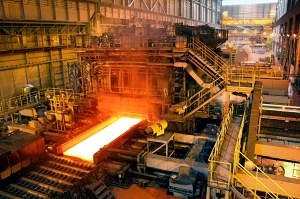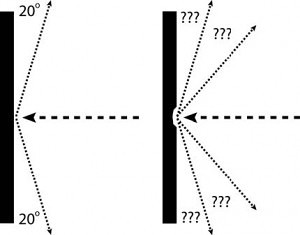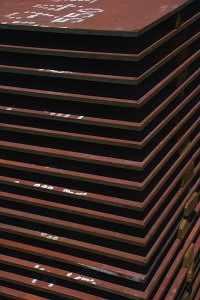With more and more companies and individuals manufacturing steel targets, the water has become increasingly muddy where accurate information is concerned. With technical data provided by the American Iron and Steel Institute in Washington D.C., this report is designed to cut through the recent hype and establish a basis of fact for accurate evaluation and comparison.
What Is Steel?
 Steel is an alloy metal composed of iron and varying amounts of carbon and/or other elements such as chromium, nickel, tungsten, manganese, and so on. Steel with specific properties and characteristics is created by adjusting the overall chemical composition or by altering the various production processes such as rolling, finishing, and heat treatment. Because each of these factors can be modified, there is potentially no limit to the number of different steel recipes that can be created. Currently, there are over 3,000 catalogued grades or chemical compositions of steel available. Steel can utilize a wide variety of alloying elements and heat treatments to develop the most desirable combination of properties.
Steel is an alloy metal composed of iron and varying amounts of carbon and/or other elements such as chromium, nickel, tungsten, manganese, and so on. Steel with specific properties and characteristics is created by adjusting the overall chemical composition or by altering the various production processes such as rolling, finishing, and heat treatment. Because each of these factors can be modified, there is potentially no limit to the number of different steel recipes that can be created. Currently, there are over 3,000 catalogued grades or chemical compositions of steel available. Steel can utilize a wide variety of alloying elements and heat treatments to develop the most desirable combination of properties.
Steel Hardness and Quality
For steel targets to be functional and safe, they should be made of high quality through hardened steel that has a Brinell hardness number (BHN) of at least 500. The steel must also provide sufficient strength, toughness, and impact resistance. The Brinell hardness test depends upon the resistance offered to the penetration of a carbide steel ball (1.6 mm diameter) when subjected to a weight of 12.6 kg. The resulting hardness value is computed as the ratio of the applied load to the area of the indentation produced. This test is accepted as a worldwide standard for measuring the hardness of steel.
Truth – There are 2 Factors that Affect the Hardness of Steel
The first is the amount of carbon and other alloying elements in its chemical composition, and the second is the manner in which the heating and cooling of the steel is manipulated. These factors are determined at the most fundamental level, and affect the finished steel as a whole.
Truth – Steel Hardness is a Critical Issue

training environment.
There are many steel mills located around the world, but only a select few are able to produce steel that is hard enough and of sufficient quality to be safely used for steel targets and equipment. Action Target has a list of major producers of Steel that meet quality specifications. Each of these companies may have minor proprietary differences in their production methods, but they all must make sheets of hard steel in essentially the same way. Nevertheless, some suppliers of targets and shooting range equipment attempt to muddy the water and create perceived differences in steel quality where none exist. One particularly misleading claim refers to a certain company’s use of through hardened steel as opposed to merely surface hardened AR500 steel allegedly used by everyone else. We state the following with all possible force:
1. Action Target uses only high quality, through hardened steel with a Brinell hardness rating of at least 500, and we use it in every one of our ballistic steel products.
2. Action Target can also provide through hardened steel targets and other steel products with certified Brinell hardness ratings of 550 and even 600.
3. Despite the inaccurate claims, AR500 steel is NOT surface hardened. It is through hardened. Witness the quotes listed below from steel suppliers around the country.
Chapel Steel – AR500 is a quenched & tempered, through hardened, wear-resistant grade of abrasion resistant steel plate used for severe impact. (SOURCE: https://www.chapelsteel.com/ar500-ar500f.html)
Heflin Steel – Heflin REM 500 abrasion resistant plate is a premium grade wear plate, ideal for extreme abrasion coupled with resistance to impact. REM 500 plate is through hardened up to a 3″ thickness for maximum hardness and abrasion resistance.
Benco Steel – AR500 is a through hardened steel with high hardness for use where there is severe impact and abrasion.
(These companies are steel suppliers, not manufacturers or producers. They buy steel from the actual manufacturers like HARDOX / SSAB, and then re-sell it to their own customers.)
4. Any statements contrary to those above are simply untrue.
Be careful not to get caught up in the “more is better” mindset. Just because a Brinell hardness number (BHN) of 500 is good, it doesn’t mean a rating of 700 is better. While you must use steel that is hard enough for the task, going overboard only impacts your checkbook and not the product durability. For example, ballistic tests have shown that the performance difference between steel with a 500 BHN and steel with a 535 BHN is so small that you can’t tell the difference with a bullet but only with a gauge. Also be aware that you can actually use steel that is too hard and too brittle for ballistic training purposes.
</ br>
Shop All Our Steel Targets







Thanks for the enlightening article on steel. It should, however, be pointed out that I don’t buy from Action Target solely based upon the steel being used, but on the second to none most excellent customer service. Action Target is without a doubt the most customer service oriented organization I have encountered to date. Thanks for being Awesome!
Flo
Flo,
Thanks for being a great customer! We’re one of your biggest fans.
I’m one of your “competitors”. I use the term kind of loosely because I’m really no competition to Action but I do make and sell steel targets. I can’t agree more with your article above. There are a lot of knuckleheads out there trying to sell mild steel as a safer alternative to AR500. You might consider expanding on this article to illuminate some design issues that inherently make a steel target more dangerous, besides using improper materials. (i.e.- improper heating of AR500 in the manufacturing process, dangerous angles encountered by poor design, etc. My business is a hobby more than a business really but I see folks ‘making targets’ that are flat out hazardous to everyone on the line.
Thanks
Will Wingfield
Will,
Thank you for the suggestion. We will probably publish a few more articles on the subject in the near future. Target safety is one of the drums we beat more than just about any other. The design of a target is just as crucial as what it is made of.
I have purchased a number of plates from you guys, and will continue to do so. However I would appreciate it if you would publish some additional standards for different speeds and distances. Half of my plates are relegated to strictly long range rifle use because of pitting.
You use the standard of 100 yards and 3000 feet per second or less. However this winter I dented/chipped my 8 inch plate at 117m with a factory .243 load. I also chipped my 12 inch plate at 220m with a factory 300 win mag load. This doesn’t bother me a whole lot because I have a completely different set of plates which I use for pistols and pistol caliber rifles so I can get up close, but not everyone can afford to have sacrificial test plates just laying around.
David,
If you could send us some additional information about your head plates including pictures, we’d like to look into this a little further. You can send that to lhelms@actiontarget.com.
Upon first glance, it looks like you just didn’t move back far enough. The .243 round (depending on the grain) almost always has a muzzle velocity well above 3,000 fps. The .300 win mag isn’t as fast, but still exceeds 3,000 by a hundred or two fps. When shooting rounds that fast, the general rule is to move back to 200 yards. You were shooting at about 128 yards, which probably wasn’t far enough back.
When it comes to standards, we usually don’t publish anything real concrete, which I know can be frustrating. The reason for that is there are too many different factors that play into a bullet’s velocity. Humidity, temperature, barometric pressure, grain, barrel length, altitude, etc. all affect muzzle velocity making it extremely difficult to say exactly how far back one should shoot from.
We will be publishing some additional information in our newsletter in the near future, but it probably won’t get too much more detailed than what I’ve just told you. If you have any additional questions, please let us know.
I recently purchased a shotgun (20 gauge). It is my first gun and I enjoy shooting at stationary targets. I really have no interest in clay, etc. I would love to use a steel target, but no one ever mentions weather using a light target load at 30-50 yards (lead pellets) would be safe.
Could you help me out on this subject?
Thanks,
Nick
Nick,
It is perfectly safe to shoot steel targets with shotgun loads. You will be safe shooting at 10-15 yards from the target with lead pellets. You especially won’t have any problems 30-50 yards back. We also suggest not using steel shot and standing 100 yards away if shooting the target with a shotgun slug.